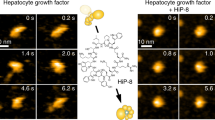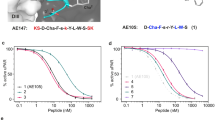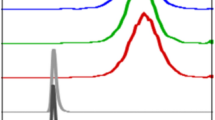Abstract
The development of therapeutic inhibitors of key signaling pathways has been hampered by the inability to assess the effect of a drug on its target in the patient. 17-allylaminogeldanamycin (17-AAG) is the first Hsp90 inhibitor to be tested in a clinical trial. It causes the degradation of HER2 and other Hsp90 targets, and has antitumor activity in preclinical models. We have developed a method for imaging the inhibition of Hsp90 by 17-AAG. We labeled an F(ab′)2 fragment of the anti-HER2 antibody Herceptin with 68Ga, a positron emitter, which allows the sequential positron-emission tomographic imaging of HER2 expression. We have used this method to quantify as a function of time the loss and recovery of HER2 induced by 17-AAG in animal tumors. This approach allows noninvasive imaging of the pharmacodynamics of a targeted drug and will facilitate the rational design of combination therapy based on target inhibition.
This is a preview of subscription content, access via your institution
Access options
Subscribe to this journal
Receive 12 print issues and online access
$209.00 per year
only $17.42 per issue
Buy this article
- Purchase on Springer Link
- Instant access to full article PDF
Prices may be subject to local taxes which are calculated during checkout






Similar content being viewed by others
References
Ebert, A.D. et al. Expression and function of EGF-related peptides and their receptors in gynecological cancer—from basic science to therapy. J. Recept. Signal Transduct. Res. 20, 1–46 (2000).
Yee, K.W. & Keating, A. Advances in targeted therapy for chronic myeloid leukemia. Expert Rev. Anticancer Ther. 3, 295–310 (2003).
Slack, J.L. & Rusiniak, M.E. Current issues in the management of acute promyelocytic leukemia. Ann. Hematol. 79, 227–238 (2000).
Paterson, S.C., Smith, K.D., Holyoake, T.L. & Jorgensen, H.G. Is there a cloud in the silver lining for imatinib? Br. J. Cancer 88, 983–987 (2003).
Mandelli, F., Avvisati, G. & Lo Coco, F. Advances in the understanding and management of acute promyelocytic leukemia. Rev. Clin. Exp. Hematol. 6, 60–71 (2002).
Ritter, C.A. & Arteaga, C.L. The epidermal growth factor receptor-tyrosine kinase: a promising therapeutic target in solid tumors. Semin. Oncol. 30 (suppl. 1), 3–11 (2003).
Baselga, J. & Hammond, L.A. HER-targeted tyrosine-kinase inhibitors. Oncology. 63 (suppl. 1), 6–16 (2002).
Nahta, R., Hortobagyi, G.N. & Esteva, F.J. Growth factor receptors in breast cancer: potential for therapeutic intervention. Oncologist 8, 5–17 (2003).
Ranson, M. & Sliwkowski, M.X. Perspectives on anti-HER monoclonal antibodies. Oncology 63 (suppl. 1), 17–24 (2002).
Sledge, G.W. Jr. Gemcitabine combined with paclitaxel or paclitaxel/trastuzumab in metastatic breast cancer. Semin. Oncol. 30 (suppl. 3), 19–21 (2003).
Khalil, M.Y., Grandis, J.R. & Shin, D.M. Targeting epidermal growth factor receptor: novel therapeutics in the management of cancer. Expert Rev. Anticancer Ther. 3, 367–380 (2003).
Anido, J. et al. ZD1839, a specific epidermal growth factor receptor (EGFR) tyrosine kinase inhibitor, induces the formation of inactive EGFR/HER2 and EGFR/HER3 heterodimers and prevents heregulin signaling in HER2-overexpressing breast cancer cells. Clin. Cancer Res. 9, 1274–1283 (2003).
Herbst, R.S. & Kies, M.S. ZD1839 (Iressa) in non-small cell lung cancer. Oncologist. 7 (suppl. 4), 9–15 (2002).
Neckers, L. Heat shock protein 90 inhibition by 17-allylamino-17-demethoxygeldanamycin: a novel therapeutic approach for treating hormone-refractory prostate cancer. Clin. Cancer Res. 8, 962–966 (2002).
Neckers, L. Hsp90 inhibitors as novel cancer chemotherapeutic agents. Trends Mol. Med. 8 (suppl.), S55–61 (2002).
Solit, D. et al. 17-allylamino-17-demethoxygeldanamycin induces the degradation of androgen receptor and HER2/neu and inhibits the growth of prostate cancer xenografts. Clin. Cancer Res. 8, 986–993 (2002).
Solit, D.B., Basso, A.D., Olshen, A.B., Scher, H.I. & Rosen, N. Inhibition of heat shock protein 90 function down-regulates Akt kinase and sensitizes tumors to Taxol. Cancer Res. 63, 2139–2144 (2003).
Rasey, J.S. et al. Quantifying regional hypoxia in human tumors with positron emission tomography of [18F]fluoromisonidazole: a pretherapy study of 37 patients. Int. J. Radiat. Oncol. Biol. Phys. 36, 417–428 (1996).
Rockoff, S.D., Goodenough, D.J. & McIntire, K.R. Theoretical limitations in the immunodiagnostic imaging of cancer with computed tomography and nuclear scanning. Cancer Res. 40(8 Pt 2), 3054–3058 (1980).
Vogel, C.L. & Franco, S.X. Clinical experience with trastuzumab (herceptin). Breast J. 9, 452–462 (2003).
Cohen, S.J. et al. Phase II and pharmacodynamic study of the farnesyltransferase inhibitor R115777 as initial therapy in patients with metastatic pancreatic adenocarcinoma. J. Clin. Oncol. 21, 1301–1306 (2003).
Hidalgo, M. & Bloedow, D. Pharmacokinetics and pharmacodynamics: maximizing the clinical potential of Erlotinib (Tarceva). Semin. Oncol. 30 (suppl. 7), 25–33 (2003).
Harris, L.N. et al. Comparison of methods of measuring HER-2 in metastatic breast cancer patients treated with high-dose chemotherapy. J. Clin. Oncol. 19, 1698–1706 (2001).
Maulik, G. et al. Modulation of the c-Met/hepatocyte growth factor pathway in small cell lung cancer. Clin. Cancer Res. 8, 620–627 (2002).
Zheng, F.F. et al. Identification of a geldanamycin dimer that induces the selective degradation of HER-family tyrosine kinases. Cancer Res. 60, 2090–2094 (2000).
Qiang, Y.W., Yao, L., Tosato, G. & Rudikoff, S. Insulin-like growth factor I induces migration and invasion of human multiple myeloma cells. Blood 103, 301–308 (2004).
Signoretti, S. et al. Her-2-neu expression and progression toward androgen independence in human prostate cancer. J. Natl. Cancer Inst. 92, 1918–1925 (2000).
Scher, H.I. et al. Changing pattern of expression of the epidermal growth factor receptor and transforming growth factor alpha in the progression of prostatic neoplasms. Clin. Cancer Res. 1, 545–550 (1995).
Arteaga, C. Targeting HER1/EGFR: a molecular approach to cancer therapy. Semin. Oncol. 30 (suppl. 7), 3–14 (2003).
Smith-Jones, P.M. et al. In vitro characterization of radiolabeled monoclonal antibodies specific for the extracellular domain of prostate specific membrane antigen. Cancer Res. 60, 5237–5243 (2000).
Acknowledgements
Department of Energy 95ER62039 (S.M.L. & P.M.S.J.), National Cancer Institute PO1 CA94060 (S.M.L., N.R. & D.B.S.), National Cancer Institute P50 CA86438 (S.M.L., N.R., D.B.S. & P.M.S.J.), D.E.J. Burke Fund for Prostate Cancer Research (F.A.) and the Taub Foundation (N.R. & D.B.S.). D.B.S. is supported in part by an American Society of Clinical Oncology/Career Development Award. The production of 64Cu at Washington University is supported by a grant from the National Cancer Institute (CA86307).
Author information
Authors and Affiliations
Corresponding author
Ethics declarations
Competing interests
The authors declare no competing financial interests.
Rights and permissions
About this article
Cite this article
Smith-Jones, P., Solit, D., Akhurst, T. et al. Imaging the pharmacodynamics of HER2 degradation in response to Hsp90 inhibitors. Nat Biotechnol 22, 701–706 (2004). https://doi.org/10.1038/nbt968
Received:
Accepted:
Published:
Issue Date:
DOI: https://doi.org/10.1038/nbt968
This article is cited by
-
PET imaging of EGFR expression using an 18F-labeled RNA aptamer
European Journal of Nuclear Medicine and Molecular Imaging (2019)
-
I-124 codrituzumab imaging and biodistribution in patients with hepatocellular carcinoma
EJNMMI Research (2018)
-
Molecular imaging using PET for breast cancer
Breast Cancer (2016)
-
Molecular imaging of targeted therapies with positron emission tomography: the visualization of personalized cancer care
Cellular Oncology (2015)



